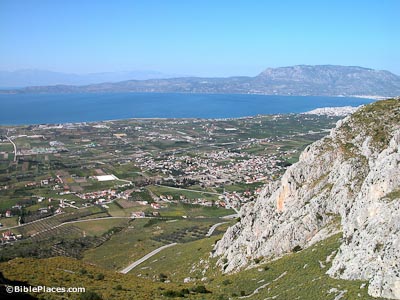
Corinth Plain
The Corinth area here is visible from the Acrocorinth above. The remains of the ancient city are located in the center of the photo (in the midst of a modern village), the ancient harbor is roughly in the center of the visible shoreline, and the isthmus is out of view to the right.
Isthmus
One of the great crossroads of the ancient world because of its location on the isthmus linking the Peloponnese to mainland Greece, Corinth was a thriving Roman colony from the time of Julius Caesar. The city is always described as "wealthy" in the ancient sources and this prosperity was due in part to the city's taxation of the north-south and east-west trade routes. This is a view to the north from the Acrocorinth. The ancient city of Corinth is just out of view to the bottom left side.
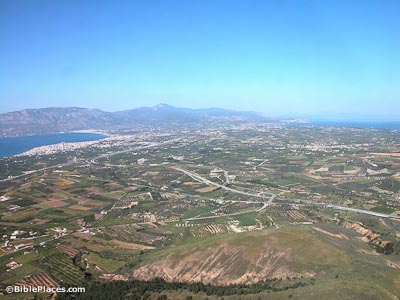
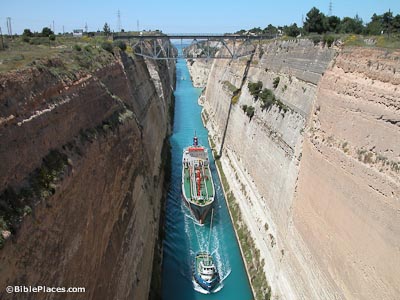
Corinth Canal
The isthmus connecting the Peloponnese and mainland Greece is four miles wide and as early as the 6th century BC, work was begun to dig a canal connecting the Corinthian and Saronic gulfs. This project failed but a paved road (the diolkos) was constructed about 600 BC to allow light ships to be hauled overland. The modern canal was completed in the late 19th century.
Corinth Diolkos
Instead of a canal, the ancients constructed a road across the isthmus to connect the two gulfs. This road, konwn as the "Diolkos" was built in about 600 BC, and allowed light ships to be hauled overland. Portions of this road are visible on the western side of the isthmus.
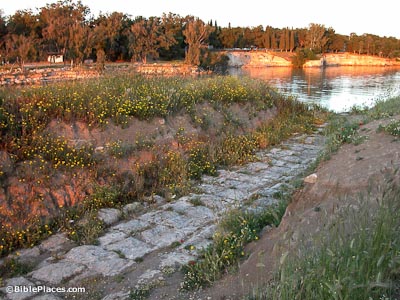
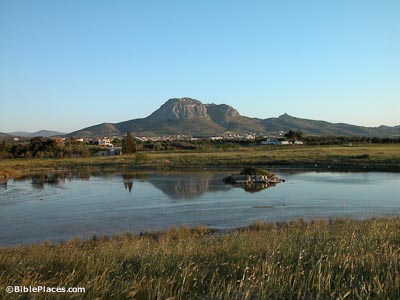
Corinth Harbor
Ancient Corinth had two harbors on the Gulf of Corinth. The northern port was known as Lechaion and is today silted up and a few hundred meters from the modern shoreline.
Cenchrea
Cenchrea was the port for Corinth on the eastern side of the isthmus, and remains of the ancient harbor are visible in the water today. Paul had his hair cut here because of a vow, and then set sail from the harbor, concluding his 18-month stay in Corinth (on his second journey; Acts 18:18).
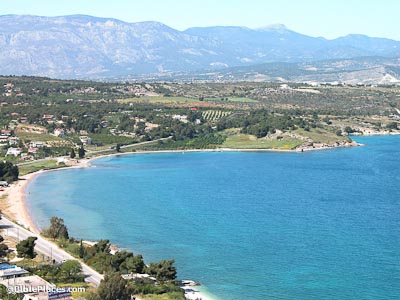


Ancient Corinth
Corinth (Greek Κορινθία) is an ancient city about 48 miles west of Athens on the narrow stretch of land that joins the Peloponnese to the mainland of Greece. Corinth was an important city in ancient Greece and it played a major role in the missionary work of the Apostle Paul. Today, Corinth is the second largest city in the Peloponnese with several sites of interest to pilgrims and tourists.
History
The site of ancient Corinth was first inhabited in the Neolithic period (5000-3000 BC), and flourished as a major Greek city from the 8th century BC until its destruction by the Romans in 146 BC.
Its commanding position on the Isthmus of Corinth, the narrow strip of land that separates the Peloponnese from northern Greece, was the primary basis of its importance. Corinth controlled the diolkos (Greek for "haul across"), the 6th-century BC stone-paved roadway that connected the Saronic Gulf with the Gulf of Corinth. This overland route was highly valuable in that it allowed passengers and cargo to avoid the difficult and time-consuming trip around the southern end of the Peloponnese.
Being a leading naval power as well as a rich commercial city enabled ancient Corinth to establish colonies in Syracuse on the island of Sicily and on Corcyra (modern Corfu). These colonies served as trading posts for the richly ornamental bronze works, textiles, and pottery that Corinth produced.
Beginning in 582 BC, in the spring of every second year the Isthmian Gameswere celebrated in honor of the sea god Poseidon. The Doric Temple of Apollo, one of Corinth's major landmarks, was constructed in 550 BC at the height of the city's wealth.
Corinth was conquered by Philip II of Macedon in 338 BC, but it was named the meeting place of Philip's new Hellenic confederacy. After Philip was assassinated, Alexander the Great immediately came to Corinth to meet with the confederacy, confirm his leadership, and forestall any thoughts of rebellion. At the Isthmian Games of 336 BC, the Greeks chose Alexander the Great to lead them in war against the Persians.
Corinth was partially destroyed by the Romans in 146 BC, but in 44 BC it was rebuilt as a Roman city under Julius Caesar. Roman Corinth prospered more than ever before and may have had as many as 800,000 inhabitants by the time of Paul. It was the capital of Roman Greece, equally devoted to business and pleasure, and was mostly populated by freedmen and Jews.
The Apostle Paul visited Corinth in the 50s AD and later wrote two letters to the Christian community at Corinth (the books of 1 and 2 Corinthians in the New Testament). When Paul first visited the city (51 or 52 AD), Gallio, the brother of Seneca, was proconsul of Corinth.
Paul lived in Corinth for 18 months (Acts 18:1-18), working as a tentmaker and converting as many Jews and pagans as he could. Here he first became acquainted with Aquila and Priscilla, who became his fellow-workers.
Although Paul intended to pass through Corinth a second time before he visited Macedonia, circumstances were such that he first went from Troas to Macedonia before stopping at Corinth for a "second benefit" (2 Corinthians 1:15). This time he stayed in Corinth for three months (Acts 20:3).
It was probably during this second visit in the spring of 58 that Paul wrote the Epistle to the Romans. Paul's First Epistle to the Corinthians, written from Ephesus, reflects the difficulties of maintaining a Christian community in such a cosmopolitan city.
A canal through the isthmus of Corinth was begun under the emperor Nero in 67 AD. Wielding a gold shovel, Nero himself was first to break ground, but the canal was not completed. Up to the 12th century, ships were dragged on rollers across the isthmus.
In 267 AD, the invasion of the Herulians initiated the decline of the city. DuringAlaric's invasion of Greece in 395–396, he destroyed Corinth and sold many of its citizens into slavery. Nevertheless, Corinth remained inhabited for many centuries through successive invasions, destructions and plagues.
After 1204, when Constantinople fell to the Fourth Crusade, Corinth was a prize sought by all. Corinth was captured by the Turks in 1458; the Knights of Malta won it in 1612; the Venetians took a turn from 1687 until 1715, when the Turks returned; and the city finally came into Greek hands in 1822.
In 1893 a 4-mile (6-km) Corinth canal was finally completed, providing an essential shipping route between the Ionian and Aegean seas. Like its ancient predecessor, modern Corinth is the center of commerce between northern and southern Greece. Today, it has a population of about 30,000.
Systematic archaeological excavations of the area, initiated by the American School of Classical Studies in 1896, are still continuing today and have brought to light the agora, temples, fountains, shops, porticoes, baths and various other monuments. The finds are exhibited in the on-site Archaeological Museum of Ancient Corinth.
What to See
The ruins of ancient Corinth, a short drive from the modern city of Corinth, are spread around the base of the rock of Acrocorinth, which forms a natural acropolis for the city. Most of the surviving buildings are Roman rather than Greek, dating from the city's prosperous age after Caesar sacked and rebuilt much of the original Greek city. Much of the city has been toppled by recurring earthquakes over the centuries.
On the Acrocorinth itself are ruins of the Temple of Aphrodite, of which little remains. The Temple of Aphrodite had more than 1,000 sacred prostitutes at one time, exemplifying the ancient city's reputation for luxury and vice. Also on Acrocorinth are the ruins of a stone minaret and ancient defensive walls.
The most notable ruin of ancient Corinth is the 6th-century BC Temple of Apollo, built on a hill overlooking the remains of the Roman marketplace (agora). Seven of the original 38 Doric columns still stand, and it is one of the oldest stone temples in Greece. The temple was still functioning in the time of Paul (50s AD) but was eventually destroyed by earthquakes.
Part of the foundation and a few pillars remain of the Temple of Octavia (known to scholars as " Temple E"), dedicated to the sister of Emperor Augustus (27 BC-14 AD). The temple represents the imperial cult of Rome, which was spread throughout the empire.
A sacred spring is located along the northern edge of the forum—near the Lechaion Road. The spring was above ground in the 5th century BC but later building activities covered it. Near the spring is a secret passage leading to a small shrine. The passage was probably used by the priests but it is unknown in exactly what capacity.
Within the Roman Forum is the Bema, the public platform where St. Paul had to plead his case when the Corinthians hauled him up in front of the Roman governor Gallio in 52 AD.
Significant ruins of the Peirene Fountain, the major source of water for Corinth, can still be seen today in the Roman Forum. It was an elaborate structure that served as a meeting place for Corinthians. Frescoes of swimming fish from a 2nd-century refurbishment can still be seen, and niche in the wall probably contained a statue. The fountain is named for Peirene, a woman who wept so hard when she lost her son that she finally dissolved into the spring that still flows here.
North of the Theater, inside the city wall, is the Asklepieion, the sanctuary of the god of healing with a small temple (4th century BC). It is set in a colonnaded courtyard with a series of dining rooms in a second courtyard. Terra-cotta votive offerings representing afflicted body parts (hands, legs, breasts, genitals, and so on) were found in the excavation of the Asklepieion, many of which are displayed at the museum.
The Archaeological Museum of Ancient Corinth contains a number of artifacts of religious interest, including inscriptions of Gallio and Erastus, both mentioned in the Book of Acts; a synagogue inscription, menorah reliefs, and votive offerings of terracotta body parts to Asklepios.
Quick Facts
Site Information
Names: Corinth
Location: Corinth, Greece
Faiths: Original/Primary: Ancient Greek
Current/Secondary: Ancient Roman
Dedication: Apollo, Aphrodite, Octavia
Categories: Greek Temples; Biblical Sites
Architecture: Greek
Features: Footsteps of Paul
Status: ruins
Photo gallery: Corinth Photo Gallery
Visitor Information
Coordinates: 37.932778° N, 22.933611° E (view on Google Maps)
Lodging: View hotels near this location
Phone: Ancient Corinth: 0741/31-443; Acrocorinth: 27410/319-66
Note: This information was accurate when published and we do our best to keep it updated, but details such as opening hours can change without notice. To avoid disappointment, please check with the site directly before making a special trip.
Article Sources
Ancient Corinth – Frommer's Attraction Review
Acrocorinth – Frommer's Attraction Review
Ancient Corinth – Fodor's Online Travel Guide
Corinth – Britannica Student Encyclopedia
More Information
Guided Tour of Ancient Corinth - Viator Sightseeing
Ancient Corinth – IgoUgo user review, June 10, 2003
Ancient Greece: Corinth – BBC Schools (for ages 4-11)
Corinth – Holy Land Photos
John McRay, Archaeology and the New Testament (Grand Rapids, MI: Baker, 1991).
from

Δεν υπάρχουν σχόλια:
Δημοσίευση σχολίου